This article provides a list of the districts of the Amhara Region of Ethiopia. [1]

Amharas are a Semitic-speaking ethnic group which is indigenous to Ethiopia, traditionally inhabiting parts of the northwest Highlands of Ethiopia, particularly inhabiting the Amhara Region. According to the 2007 national census, Amharas numbered 19,867,817 individuals, comprising 26.9% of Ethiopia's population, and they are mostly Oriental Orthodox Christian.
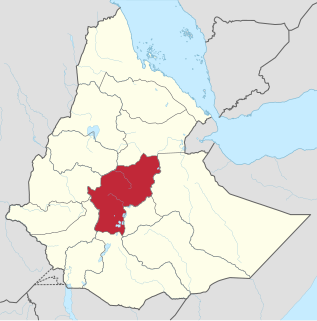
Shewa, formerly romanized as Shua, Shoa, Showa, Shuwa, is a historical region of Ethiopia which was formerly an autonomous kingdom within the Ethiopian Empire. The modern Ethiopian capital Addis Ababa is located at its center. Modern Shewa includes the historical Endagabatan province.

Weldiya or Woldia is a town, woreda, and capital of the North Wollo Zone in northern Ethiopia. Located north of Dessie and southeast of Lalibela in the Amhara Region, this town has an elevation of 2112 meters above sea level.
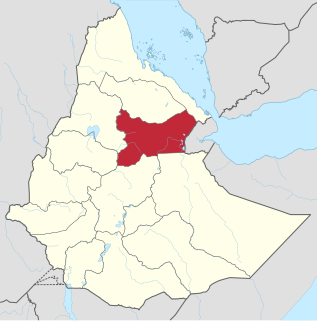
Wollo was a historical province of northern Ethiopia that overlayed part of the present day Amhara, Afar, and Tigray regions. During the Middle Ages this region was known as Bete Amhara and had Amhara kings. Bete Amhara had an illustrious place in Ethiopian political and cultural history. It was the center of the Solomonic Dynasty established by Emperor Yekuno Amlak around Lake Hayq in 1270, the original center of Amhara people, whose territorial reach extended from Lake Hayq and the Beshillo River in the north, the Afar and Argobba lowlands in the east, the Abbay River in the West, and the Awash River just south of modern Addis Ababa.
Amhara may refer to:
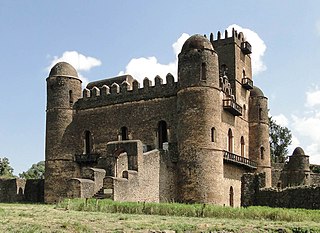
The Amhara Region, officially the Amhara National Regional State, is a regional state in northern Ethiopia and the homeland of the Amhara people. Its capital is Bahir Dar which is the seat of the Regional Government of Amhara. Amhara is the site of the largest inland body of water in Ethiopia, Lake Tana, and Semien Mountains National Park. Amhara is bordered by Sudan to the west and northwest and by other the regions of Ethiopia: Tigray to the north, Afar to the east, Benishangul-Gumuz to the west and southwest, and Oromia to the south.
Ambassel is a woreda in Amhara Region, Ethiopia, and an amba, or mountain fortress, located in the woreda. The word Ambasel is derived from two words "Amba" from the Amharic word for plateau, and “Asel” from the Arabic language, which means honey. Together, it means “plateau of honey” or the “land of honey” the woreda is named for this feature. Located in the Debub Wollo Zone, Ambassel woreda is bordered on the west by the Bashilo which separates it from Tenta, on the north by the Semien Wollo Zone, on the southeast by the Mille River which separates it from Tehuledere, and on the south by Kutaber; the Walano, a tributary of the Bashilo, defines most of its southern border. Its largest town is Wuchale.

North Wollo also called Semien Wollo, is a zone in Amhara Region of Ethiopia. It is bordered on the south by South Wollo, on the west by South Gondar, on the north by Wag Hemra, on the northeast by Tigray Region, and on the east by Afar Region; part of its southern border is defined by the Mille River. Its highest point is Mount Abuna Yosef. Its towns include Lasta Lalibela and Weldiya. North Wollo acquired its name from the former province of Wollo.

North Shewa is a zone in the Amhara Region of Ethiopia. North Shewa takes its name from the kingdom and former province of Shewa. The Zone is bordered on the south and the west by the Oromia Region, on the north by South Wollo, on the northeast by the Oromia Zone, and on the east by the Afar Region. The highest point in the Zone is Mount Abuye Meda, which is found in the Gish woreda; other prominent peaks include Mount Megezez. Towns in North Shewa include Ankober, Debre Birhan, and Shewa Robit.
Meket is a woreda in Amhara Region, Ethiopia. It is named after a former district located approximately in this area. Located on the western side of the Semien Wollo Zone, Meket is bordered on the south by Wadla and Dawunt, on the west by the Debub Gondar Zone, on the northwest by Bugna, on the north by Lasta, on the northeast by Gidan, and on the east by Guba Lafto. The administrative center of Meket is Filakit Gereger; other settlements include Agrit, Arbit, Gashena and Debre Zebit.
Guba Lafto is one of the woredas in the Amhara Region of Ethiopia. Part of the Semien Wollo Zone, Guba Lafto is bordered on the south by the Debub Wollo Zone, on the west by Delanta and Wadla, on the northwest by Meket, on the north by Gidan, on the northeast by the Logiya River which separates it from Kobo, and on the southeast by Habru. Weldiya is an enclave inside this woreda. Towns in this woreda include Hara.
Sayint is a woreda in Amhara Region, Ethiopia. It is named after the historical district of Amhara Sayint which was located in the same area. Part of the South Wollo Zone, Sayint is bordered on the south by Debre Sina and Mehal Sayint, on the west by the Blue Nile that separates it from the East Gojjam Zone, on the northwest by the Bashilo River that separates it from the South Gondar Zone, on the north by Magdala, on the east by Tenta and on the southeast by Legambo. The major town in Amhara Sayint is Ajibar. Mehal Sayint was created by separating it from the historic Amhara Sayint woreda.
Argobba is one of the Districts of Ethiopia, or woredas, in the Amhara Region of Ethiopia. Because Argobba is not part of any Zone in the Amhara Region, it is considered a Special woreda, an administrative subdivision which is similar to an autonomous area. This woreda is named for the Argobba people, whose homeland lies in this district. Argobba is bordered on the west by the Debub Wollo Zone, and on the east and south by the Oromia Zone. Argobba was created mainly from Kalu woreda with smaller parts from Chefe Golana Dewerahmedo woreda.
The 2021 Ethiopian general election to elect members of the House of Peoples' Representatives was held on 21 June 2021 and 30 September 2021. Regional elections were also held on those dates.
The 2019 Amhara Region coup d'état attempt was an attempted coup d'état against the Amhara Regional government on 22 June 2019, during which factions of the Amhara Region's Peace and Security Bureau assassinated the Amhara Regional President Ambachew Mekonnen. A bodyguard siding with the nationalist factions also assassinated General Se'are Mekonnen, the Chief of General Staff of the Ethiopian National Defense Force, as well as his aide Major General Gizae Aberra.
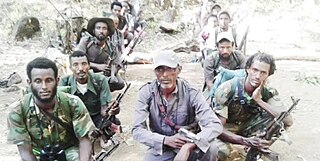
Fano ፋኖ is a historical term used in Ethiopian struggles against injustice and foreign invaders. It is mainly shown as a youth movement that has played a significant role in preserving the concept of Ethiopian nationhood. As a youth group, it has emerged from within the Amhara ethnic group and has features of reminiscent of classical political, religious, or even social movements that drive youthful frustrations into acts of agitation until they achieve a measure of reform. Traditionally, the Fano struggle had focused on fending off attacks against Ethiopia. In recent years, Fano has become a household name and a crucial movement tasked with saving the very existence of the Amhara population as well as the integrity of Ethiopia. In this, it differs from other similar youth movements in the country, whose aim is to dismember the Ethiopian state into ethnic components. Fano is made of a defiant and patriotic youth which is able to shoulder an Ethiopia that is arising from the ashes bequeathed to them. This revolutionary generation and movement has to be nurtured. Fano is not just an embodiment of the physical defiance but also an intellectual movement that abhors ethnic fascism, narrow nationalism, apartheid policies, internal colonialism and all forms of pseudo-legal acts of political corruption. Instead, it upholds a civic sense of public duty, patriotism and vision for the good of the entire country.

The Benishangul-Gumuz conflict is an armed conflict mostly in the Metekel Zone of the Benishangul-Gumuz Region in Ethiopia that started in 2019.
The 2020–2022 Ethiopian–Sudanese clashes are an ongoing conflict between Sudan and Ethiopia, together with Amhara militants and Eritrea, in the disputed border region of al-Fashaga. Since 2008, Ethiopia has dropped all claims to the al-Fashaga as long as Sudan allowed Ethiopian farmers and militants to stay in the area undisturbed. With the outbreak of the Tigray War, Sudanese forces were able to move into the region due to an agreement with Ethiopia just three days before. When Amhara militants left to assist the federal government in the war, Sudanese forces started to drive out Ethiopian farmers, including the Amhara, effectively breaking the 2008 compromise. Ethiopia has also accused Sudan of killing Amhara farmers.
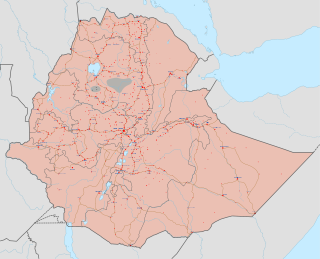
Many of the roots of the ongoing civil conflict within Ethiopia date back to the mid-twentieth century and earlier. Following the 2018 dissolution of the ethnic federalist, dominant party political coalition, the Ethiopian People's Revolutionary Democratic Front, there was an increase in tensions within the country, with newly resurgent regional and ethnically based factions carrying out armed attacks on military and civilians in multiple conflicts throughout Ethiopia.

The Amhara genocide is an ongoing systematic massacre of ethnic Amhara and Agew people in Ethiopia since 1990. Large-scale killings and grave human rights violations followed the implementation of the ethnic-federalist system in the country. In most of the cases, the mass murders were silent with perpetrators from various ethno-militant groups— from Tigray TPLF or TDF, Oromo OLF–OLA, which are also known as Sene/Shane (ሸኔ), Oneg (ኦነግ), and the Gumuz armed groups. Ethnically motivated attacks against the Amhara have been reported, with mass graves continuously discovered in various locations. Many from the victim side stated that attempts to investigate and to uncovering data expose them to various forms of persecution. However, the results of two consecutive National Census Analyses and a report by the State revealed that over 2 million Amhara could not be traced. The figure reflects the decades-long massacres and enforced disappearances of the Amhara people. From the ongoing nature of the violence, the actual number is expected to be higher.